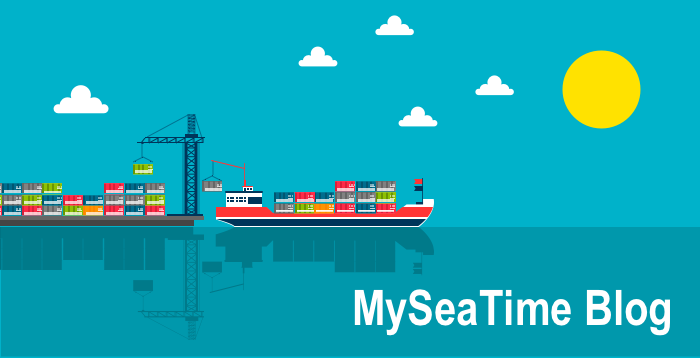There are different criteria on which bill of ladings can be defined and differentiated.
Few of these criteria being the “place from where carriers takes the responsibility of the cargo” (Port to port, Multimodal and through bill of ladings) or if the owner of the cargo can sell the cargo before it reaches by transferring the title of the bill of lading (Negotiable and non-negotiable bill of lading)
Different types of bill of ladings based upon Negotiable and non Negotiable documents
The main difference between the two types is the title (ownership) of the bill of lading.
While one can be transferred to another party, the other is consigned to a named party and hence he/she has to be the final recipient of the cargo as the title of this type of bill of ladings cannot be transferred.
Readers should not confuse the negotiable and non-negotiable types of bill of ladings with the “negotiable” and “non-negotiable” copies of the signed bill of ladings.
1. Straight bill of lading:
The straight bill of lading is specified to the particular party and the specified party cannot re-assign it to anyone else. The party only has to take the delivery of the cargo and the cargo cannot be sold by transferring the bill of lading to another party’s name.
Q: Can you think of an example when the straight bill of lading can be and will be used?
2. Order bill of lading
This is the bill of lading that one would mostly come across onboard. The bill of lading is to the consignee or to his order. That is the named consignee will be the owner of the cargo or he can order the shipment to be delivered to another party by endorsing the bill of lading to that party.
As the title (ownership) of the bill of lading can be transferred, the Order bill of lading is the negotiable document.
3. Bearer bill of lading
The bearer bill of lading is the one in which the bearer of the bill of lading is the owner of the cargo and there is no consignee named in the bill of lading.
This kind of bill of lading is very seldom found as there are huge risks involved in the misuse of this kind of bill of ladings.
Again as the title (ownership) of the bill of lading can be transferred, the Order bill of lading is a negotiable document.
4. Switch bill of lading
This can said to be the duplicate bill of lading for a cargo of which the bill of lading was already issued.
Switch bill of lading is generally requested by the consignee from the owner of the vessel when the consignee does not wish to reveal to the new buyer the identity of the shipper of the cargo.
Types of Bill of ladings based upon carriers responsibility
1. Port to port bill of lading (also called Ocean bill of lading)
In this kind of bill of ladings, Carrier’s responsibility starts at the port of loading and ends at the port of discharge
2. Multimodal or Combined bill of lading
This kind of bill of lading covers more than one mode of transfers (for example, Ocean and rail or Ocean and road) and covers all the modes of transfers.
Carrier has the responsibility from a place of receipt to place of delivery of the cargo.
Carrier can hire/subcontract to carry the cargo in one or more modes of transfers.
3. Through bill of ladings
The main difference between multimodal and through bill of lading is that in through bill of lading there is only one mode of cargo movement but has different legs, like sea and inland waterways.
Whereas in the multimodal bill of lading there have to be at least two modes of cargo movement (like sea and land).
With respect to carrier’s responsibility, in through bill of lading, the carrier is responsible only for their leg of sea transport.
Many believe there is no difference between the Multimodal and through bill of ladings which is not correct.
* If you think there is another important bill of lading that has been missed out here, please share in the comment section and I would be happy to include that in this blog.
Share this:

About Capt Rajeev Jassal
Capt. Rajeev Jassal has sailed for over 24 years mainly on crude oil, product and chemical tankers. He holds MBA in shipping & Logistics degree from London. He has done extensive research on quantitatively measuring Safety culture onboard and safety climate ashore which he believes is the most important element for safer shipping.
Search Blog
49 Comments


maybe also mention shipped vs received for shipping and waybills?

kindly also comment on a bill of lading with consignee as "to order" and notifiy (generally mentioning the buyer's name.

Sir, can you please clarify What is the meaning of “negotiable” and “non-negotiable” copies of signed bill of ladings??

A negotiable bill of lading instructs the carrier to deliver goods to anyone in possession of the original endorsed negotiable bill, which itself represents title to and control of the goods. ... Because of this, a negotiable bill of lading must be used for a documentary sale.

Traditional bill of lading is a document of title so you can transfer the ownership of the goods to another party by means of endorsement or delivery. For this reason buyers have to present at least one original bill of lading to the carrier at the port of discharge. Non negotiable bill of lading is not a document of title. As a result buyers do not have to present at least one original bill of lading to the carriers at the port of discharge. Also you cannot transfer the ownership of the goods to another party by means of endorsement or delivery under non negotiable bill of lading. That is why non negotiable bill of lading is called non negotiable sea waybill. It is not a bill of lading in a traditional sense. Main Differences : Consignee: Bill of lading can be issued in a negotiable form. Non negotiable sea waybill cannot be issued in a negotiable form. You should to indicate your buyers name on the non negotiable sea waybill. Endorsement: Only bill of lading can be endorsed. Non negotiable sea waybill cannot be endorsed. Delivery of Goods: Under traditional bill of lading buyer have to present at least one original B/L to the carrier’s agent at the port of discharge. Otherwise they cannot get the goods unless letter of indemnity is issued. Under non negotiable sea waybill buyers can claim the goods by confirming their identity.

from my little knowledge i have about a bill of lading, i think a bill of lading is said to be negotiable when ownership can be transferred by the actual owner to anyone he chooses to claim the goods,and this can be done by signing of a signature.

not necessarily the owner. it can be the carrier while goods are still in trasit to the named port of discharge.

plz expalin something abt documementry credit system

There are two bill of ladings missed which are clean bill of lading and clause bill of lading.please investigate them.

These are not types of B/l.

Stale bill of lading...

if the b/l is not submitted to bank within specified time under documentary credit system.the b/l thus becomes the stale b/l

International sales of goods contract between buyer and seller contains various terms and conditions and one of the term is about how payment of goods will be done. If both of the parties agrees to payment using Letter of credit / Documentary credit system then it is clearly mentioned in sales contract. However, Letter of credit which is issued by buyer's bank is also based on various conditions say B/L should be clean and to be presented in between some period ( say 01/06 - 15/06) but due some issues if its presented to bank after 15/06 then that will be called a STALE B/L . Don't confuse it with unclean/dirty/claused/foul/spoiled BL which is different from stale B/L. So , in short it can be said as "a B/L which is presented to bank after date mentioned in Letter of credit wil be termed as a STALE B/L".

Thanks Captain , the blog is very knowledgeable.

Do you have information about the split bill of lading and groupage bill of lading

Split B/ls are issued more or less like the switch B/l. It is a practice usually found with bulk trade where the shipper may sell the cargo at POD to more than one receiver. Simply put one cargo many receivers . Groupage is where many shippers engage one freight forwarder to send their cargo under the same b/l. Receivers may be one or many.

Hi, in general if the B/L is termed non-negotiable it does not qualify as a B/l but is then termed as a sea waybill. A bill of lading should be negotiable.

What is the difference between charter party bill of lading & CONGENBILL 2017

dear sir, can you please explain when does a B/L becomes actual contract of carriage. I assume it is an evidence of contract of carriage. Please answer. Thank you sir.

generally which type of bill of lading use in tanker trade.

Please explain commingle bill of lading.

Hi, I have a question regarding the change of “consignee” in a B/L. Suppose, there is a cargo coming to India with a straight B/L with a named “Consignee” mentioned therein. Now, once the cargo reached in India, the buyer (importer) refuses to clear the cargo from port siting an issue with the previous consignment’s quality. The buyer wants to press the “Shipper” and thereby bringing him to negotiation for a price discount. The buyer has not yet paid for the goods, so practically the ownership/title of the cargo vests with the “Shipper”. In this case, can “Shipper” request to change the “Consignee” in B/L? and, is it possible to change it without obtaining a NOC (no objection certificate) from the existing “Consignee”? Kindly explain the legal position and rights of a “Shipper” in reference to Indian Law since he would suffer a great loss if the consignee refuses to provide NOC. Please quote provisions and relevant citations, if possible. Thanking you,

Why master need to be careful while signing a Order bill of lading??

What is the difference between Hague rules, Hague visby rules, Hamburg & Rotterdam rules for Bill of lading. Which rule is widely used.

Why the consignee does not wish to reveal to the new buyer the identity of the shipper of the cargo. Cause as i know. That switch b/l needed some agreement from consignee, shipper and newe buyer of final buyer

nice blog sir....

I want to know more about the Shipping industry

What is the appreciable difference between a Charter Party bill of lading & Ocean Bill of Lading which prompts certain banks to mention under their LCs "Charter Party Bills of lading not acceptable".

Sos Kredit: Finanzierung / Kredit / Darlehen Der Kredit von Privat bringt verschiedene Vorteile mit sich. Im Gegensatz zum normalen Bankkredit müssen Sie nicht durch eine Vielzahl an bürokratischen Hürden steigen, sondern beantragen Ihren Kredit von Privat bequem von zu Hause. Ist der Kreditantrag beim Kredit von Privat für Sie vollkommen kostenlos . Nach Abschluss des Kreditantrags identifizieren Sie sich online und unterschreiben Ihr Kreditvertragsangebot. Auch die Unterschrift findet bei mit dem eSign online statt. Daraufhin wird Ihr Kredit umgehend ausgezahlt -bestenfalls in wenigen Stunden Kontaktieren Sie mich einfach: soscredite@gmail.com und Sie erhalten die Hilfe, die Sie benötigen http://sofortkreditfinanzierung.wpweb.fr Sofortzusage Zinssatz 3% p.A. Laufzeit bis 380 Monate Danke

Wir bieten 100% vertraulichen Service, um alle Ihre Finanzierungsbedürfnisse zu erfüllen Eine schnelle und einfache Lösung, um ein geschäftliches, persönliches Darlehen mit sehr flexiblen Bedingungen zu erhalten, das je nach angefordertem Betrag zwischen 1,5% und 6% variiert Stellen Sie Ihre Anfrage und erhalten Sie eine sofortige Antwort Betrag zwischen 2.000 und 1.500.000 Euro Erhalten Sie es innerhalb von maximal 48/72 Stunden Lösungen Bestehen, wenn Sie in der Lage sind, die Verpflichtungen Ihrer Anfrage zu erstatten und zu erfüllen. Email: soscredite@gmail.com Sofortzusage Zinssatz 3% p.A. Laufzeit bis 360 Monate http://sofortkreditfinanzierung.wpweb.fr Danke

Das private Darlehen von 3'000 bis 400'000 €, Zinssatz von 4,4%. Ihre Anfrage in 3 Minuten, Ihr Angebot in 24 Stunden Haben Sie Pläne? Wir haben das richtige Darlehen für Sie. Benötigen Sie eine bestimmte Art der Finanzierung? Wir passen unsere Angebote an Ihre Wünsche an und bieten Ihnen unsere verschiedenen Kreditoptionen an. Finanzierung / Kredit / Investition / Sofortkredit Info-online: weuronex@gmail.com Es ist einfach, schnell und diskret.

Hallo meine Damen und Herren, benötigen Sie finanzielle Hilfe? Ich bin Max Bent. Ich bin Kreditgeber und auch Finanzberater. Benötigen Sie einen dringenden Kredit, um Ihre Schulden zu begleichen, oder benötigen Sie einen Eigenkapitalkredit, um Ihr Geschäft zu verbessern? Wurden Sie von Banken und anderen Finanzinstituten abgelehnt? Benötigen Sie eine Kreditkonsolidierung oder Hypothek? Suchen Sie nicht mehr, denn wir sind hier, damit all Ihre finanziellen Probleme der Vergangenheit angehören. Kontaktieren Sie uns per E-Mail: oceanfmortgages@gmail.com oceanfmortgages@gmail.com Dies ist Ocean Finance Hypotheken. Wir bieten Interessenten Kredite zu einem angemessenen Zinssatz von 2% an. Die Spanne reicht von 5.000,00 Euro bis maximal 100.000.000,00 Euro.

Darlehen. Finanzierung. Refinanzierung. Hypotheken. Persönliche Kredite (Versicherung). Kredit für Investitionen. Automatische Ausleihe. Konsolidierung von Darlehen. Kreditunternehmen. Geschäftskredite (garantiert). Schuldenkonsolidierung. Online-Kredit. Zweite Hypothek. Von 5000 € bis 200.000 € Von 200.000 € bis 900.000 € Sofortzusage 100 flexibel Zinssatz 3% p.A Laufzeit bis 380 Monate, Email: soscredite@gmail.com sofortkreditfinanzierung.wpweb.fr

Darlehen. Finanzierung. Refinanzierung. Hypotheken. Persönliche Kredite (Versicherung). Kredit für Investitionen. Automatische Ausleihe. Konsolidierung von Darlehen. Kreditunternehmen. Geschäftskredite (garantiert). Schuldenkonsolidierung. Online-Kredit. Zweite Hypothek. Von 5000 € bis 200.000 € Von 200.000 € bis 900.000 € Sofortzusage 100 flexibel Zinssatz 3% p.A Laufzeit bis 380 Monate, Email: soscredite@gmail.com sofortkreditfinanzierung.wpweb.fr

Hallo Für alle Ihre finanziellen Bedürfnisse ist die Organisation finances plus dazu bestimmt, allen seriösen, zuverlässigen und aufrechten Personen, die einen Kredit aufnehmen möchten, kurz- und langfristige private Kredite im Bereich von 5.000 bis 10.000.000 Euro zu gewähren. Mein Zinssatz beträgt 3%, abhängig vom geliehenen Betrag und der Dauer der Geldrückgabe, da ich insbesondere nicht gegen das Wuchergesetz verstoßen möchte. Sie können je nach geliehenem Betrag maximal 5 bis 35 Jahre zurückzahlen. Sie müssen einen Kredit aufnehmen: Hier sind die Bereiche, in denen ich Ihnen helfen kann: * Finanzierung * Wohnungsbaudarlehen * Investitionsdarlehen * Autokredit * Zweithypotheken * Privatkredite * Kein Nachweis erforderlich, um einen zu unterstützen Person in schwieriger Situation Sie stecken im verbotenen Bankgeschäft fest und Sie haben nicht die Gunst von Banken, oder besser, Sie haben ein Projekt und benötigen eine Finanzierung, eine schlechte Kreditauskunft oder brauchen Geld, um Rechnungen zu bezahlen, Geldmittel von Investition in Unternehmen. Unsere Organisation ist keine Bank und wir fordern nicht viele Dokumente an. Wenn Sie also einen Kredit benötigen, zögern Sie nicht, mich zu kontaktieren, um mehr über meine Bedingungen zu erfahren. Bitte kontaktieren Sie mich direkt per E-Mail: soscredite@gmail.com Sofortzusage Zinssatz 3% p.A. Laufzeit bis 360 Monate http://sofortkreditfinanzierung.wpweb.fr Danke

I'm Harper Liam,here in Texas. I have been suffering from this terrible breath,(HALITOSIS)i have been dealing with bad breath for 7 years nothing seem to work,i brushed and flossed twice every day tried all bad breath products,going to Doctors nothing seem work an is very painful living with such a big diseases, at first i feel it was due to the food and not brushing my teeth twice daily was the case but little did i know it was not the problem sometime speaking in public i discover people around me were never comfortable when i speak, getting close to person was really a big problem,i feel smell from my mouth so i have to brush twice yet things were getting worst so i have to see a doctor who told me i have bad breath so he recommended some drugs for me to apply,first Mouthwashes antibacterial Chlorhexidine, Cetylpyridinium chloride i keep using all this product i was never comfortable with this so i try all means seeking for possible solution from various hospital nothing seen to work doc keep recommending same drugs to apply it was really worst i try all and all nothing good work,i do some search for solution for my bad breath, where i saw some comment and videos on YouTube about Dr Ose Odiagbe, how they get cure of bad breath and other related disease with his Herbal drugs so i sent he an email on his email address;dr.oseodiagbe@gmail.com i told he about my halitosis, he reply back asking some questions and what i should do and not to do during intake of his herbal drugs which i comply i got it within 3 working days via Dhl he gave the instruction how i can apply it which i followed within 3 weeks my bad breath get rid off just like mericle my halitosis was gone just want to thanks Dr Ose Odiagbe for his good work you can contract he on his mobile line or Whats App +2349060666954 or email he on his email address @ dr.oseodiagbe@gmail.com

Transportation Tracking Software track vehicles & loads with the help of TMS by tracing for planning, theft prevention, mileage administration and to inform your customer about the consignment. Transportation management software is a technology platform which helps an enterprise plan, manage, execute, track and improve all their logistics operations.

Brauchen Sie einen Kredit? Wenn ja, kontaktieren Sie uns bitte unter: dakany.endre@gmail.com

Dobrý den, potřebujete urgentní půjčku paní strnadová, je spolehlivým poskytovatelem půjčky, můžete mít půjčku od 500 000 Kč do 20 000 000 Kč s běžnou sazbou, pokud potřebujete půjčku naléhavě, kontaktujte ji na email: strnadovahana@9gmail. com

Dobrý den, potřebujete naléhavou půjčku paní strnadové, můžete být spolehlivým poskytovatelem půjček, mít půjčku od 50 000 Kč do 15 000 000 Kč s běžnou sazbou 3%, pokud potřebujete půjčku naléhavě, kontaktujte e-mail: strnadovahana9@gmil.com nebo +420 608 136 440

Benötigen Sie einen Kredit? persönliche Darlehen? Geschäftskredite? Hypothekendarlehen? Agrar- und Projektförderung? Wir vergeben alle Arten von Krediten zu 2 % Zinsen! Kontakt-E-Mail; (dakany.endre@gmail.com) Bieten Sie dringende Kredite an.

Benötigen Sie finanzielle Hilfe? Persönliche Darlehen? Kredite? Hypothekendarlehen? Geschäftskredite? Landwirtschaft und Projekte finanzieren? Wir vergeben Kredite zu 2% Zinsen! Kontakt: dakany.endre@gmail.com

Suchen Sie ein Geschäftsdarlehen, Privatdarlehen, Hypotheken, Autodarlehen, Studentendarlehen, Schuldenkonsolidierungsdarlehen, unbesicherte Darlehen, Risikokapital zu einem niedrigen Zinssatz und einem erschwinglichen Zinssatz von 2 %? Antworten Sie uns per E-Mail: dakany.endre@gmail.com

Hallo, Benötigen Sie dringend einen Kredit? Wir bieten Bildungsdarlehen, Geschäftsdarlehen, Wohnungsbaudarlehen, Agrardarlehen, Privatdarlehen, Autodarlehen und andere gute Gründe zu 2 % an. Kontaktieren Sie uns: (dakany.endre@gmail.com) für weitere Details Dringendes Kreditangebot.

Brauchen Sie einen Kredit? Privatkredit? Wirtschaftskredite? Hypothek? Landwirtschaftliche und Projektfinanzierung? Wir bieten alle Arten von Darlehen mit 2% Zinsen an! Kontaktieren Sie uns per E -Mail: dakany.endre@gmail.com

who issues bl for multimodel or combined bl
Leave Comment
More things to do on myseatime

MySeaTime Blogs
Learn the difficult concepts of sailing described in a easy and story-telling way. These detailed and well researched articles provides value reading for all ranks.

Seafarers Question Answers
Ask or answer a question on this forum. Knowledge dies if it remains in our head. Share your knowledge by writing answers to the question

MySeaTime Podcast
This podcast on the maritime matters will provide value to the listeners. Short, crisp and full of value. Stay tuned for this section.


Required types of b/l with pictures
Darlehen 100% kostenloses Wir bieten 100% vertraulichen Service, um alle Ihre Finanzierungsbedürfnisse zu erfüllen Eine schnelle und einfache Lösung, um ein geschäftliches, persönliches Darlehen mit sehr flexiblen Bedingungen zu erhalten, das je nach angefordertem Betrag zwischen 1,5% und 6% variiert Stellen Sie Ihre Anfrage und erhalten Sie eine sofortige Antwort Betrag zwischen 100.000 und 1.500.000 Euro Erhalten Sie es innerhalb von maximal 48/72 Stunden Lösungen Bestehen, wenn Sie in der Lage sind, die Verpflichtungen Ihrer Anfrage zu erstatten und zu erfüllen. Email: soscredite@gmail.com / http://sofortkreditfinanzierung.wpweb.fr Sofortzusage Zinssatz 3% p.A. Laufzeit bis 360 Monate http://sofortkreditfinanzierung.wpweb.fr Danke
Brauchen Sie einen schnellen Kredit? Wir bieten Darlehen von 5'000 € bis 500'000 € mit einer Antwort innerhalb von 24 Stunden, wenn Sie nicht Gegenstand eines Gerichtsverfahrens sind. Finanzierung / Kredit / Investition / Sofortiger Info-Online-Kredit: weuronex@gmail.com Es ist einfach, schnell und diskret.